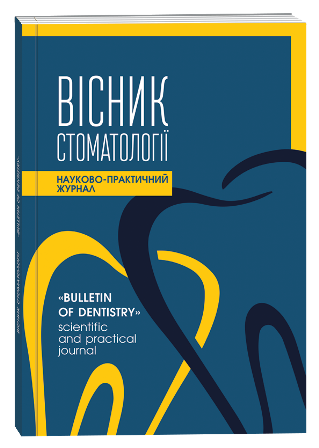ANTHROPOMETRIC CHANGES IN UPPER LIP AND HARD PALATE TISSUES IN CHILDREN WITH CONGENITAL NON-FUSION
DOI:
https://doi.org/10.35220/2078-8916-2024-51-1.24Keywords:
non-fusion of the lip and palate, cleft lip and palate, photogrammetry, upper jaw, CAD / CAM.Abstract
Modern surgical protocols for the treatment of children with congenital unilateral non-fusion of the lip and palate (CUNFLP) use the principles of early surgical treatment. The criteria for evaluating treatment results are aimed at studying the primary condition of soft tissues of the nasolabial complex (NLC) and the development of the upper jaw. Therefore, an objective, complete and accessible assessment of the state of NLC is important for choosing the method of surgery. Materials and methods. A study of 58 children with CUNFLP prior to surgical treatment was conducted. The mean age of the children was 4±2 months. All children underwent photogrammetry and scanning of models of the upper jaw. NLC was performed according to its own methodology. Results. Analysis of NLC indicators in children with CUNFLP before photometric surgery showed changes in all its values. Before surgery, the ratio of oral slit width to interocular distance (en-en/ch-ch) was increased by 19 % compared to the norm. This indicator is explained by the presence of a defect and depends on its width. This indicator is explained by the presence of a defect and depends on its width. The ratio of distances from the corner of the mouth to the elevation of the Cupid's bow on the healthy and non-fused sides (ch-cph/ch-cphd) to cheilorinoplasty was increased by 15% compared to the norm, which indicates an asymmetry between fragments due to soft tissue deficiency in the small fragment. The ratio of the height of the filtrum columns to cheilorinoplasty (cph-cph’/cphdcphd’) was increased by 2.5 times compared to the norm. Such a change indicates a sharp deficit in the height of the filtrum column on the side of non-fusion and indirectly indicates a deficiency of the skin-muscle-mucous complex of tissues. Conclusions. According to photogrammetric data, the following indicators were most changed in children with CUNFLP before cheilorinoplasty: the height of the filtrum columns was reduced by 2.5 times, the length of the upper lip was reduced by 1.2 times, the distance from the angle of the mouth to the elevation of Cupid's bow was 1.15 times, the ratio of the length and width of the nostril on the side of non-fusion was 1.5 times. The latter affect the development and position of the anterior and middle segments of the upper jaw, which is caused by the pathology of continuity m.orbicularis oris and lack of action of the upper lip and frontal fragments of the upper jaw. Analysis of anthropometric data on the location of fragments of the upper jaw showed that the greatest changes are experienced by a large fragment that has a protrusion position due to the action of the muscles of the upper lip and a small prisinku. According to the transversal, an increase in width was found in the projection of the icicles and the base of the jaw, while in the middle area the width remains normal. Such indicators may be creditors of the development of narrowing of the upper jaw in the middle part after the defect is eliminated. Correlation of Transversal size indicators in children with CUNFLP indicates a relationship between them, but does not show a relationship with the size of the defect. Such results may indicate that changes in the transversal size of the upper jaw occur due to primary operations performed, but do not have any connection with the size of the defect. This feature can be explained by the fact that the change in the position of the teeth occurs at the level of dentoalveolar X movements, and the defect of the hard palate itself refers to skeletal anomalies.
References
Яковенко Л.М., Шафета О.Б., Борисова Є.С. Спосіб оцінки тканин назолабіального комплексу у дітей з вродженими незрощеннями верхньої губи та носа після хейлоринопластики. Патент на корисну модель № 126667, 25.06.2018, бюл. № 12
Antonarakis G. S., Tompson B. D., Fisher, D. M. Preoperative Cleft Lip Measurements and Maxillary Growth in Patients With Unilateral Cleft Lip and Palate. The Cleft palate-craniofacial journal. 2016. № 53(6). Р. e198–e207. https://doi.org/10.1597/14-274
Hathaway R., Daskalogiannakis J., Mercado A., Russell K., Long R. E., Jr Cohen M., Semb G., Shaw W. The Americleft study: an intercenter study of treatment outcomes for patients with unilateral cleft lip and palate part 2. Dental arch relationships. The Cleft palatecraniofacial journal. 2011. №48(3). Р. 244–251. https:// doi.org/10.1597/09-181.1
Hammoudeh J. A., Imahiyerobo T. A., Liang F., Fahradyan A., Urbinelli L., Lau J., Matar M., Magee W., Urata M. Early Cleft Lip Repair Revisited: A Safe and Effective Approach Utilizing a Multidisciplinary Protocol. Plastic and reconstructive surgery. Global open. 2017. №5(6). Р. e1340. https://doi.org/10.1097/GOX. 0000000000001340
Філоненко В.В. Раннє ортодонтичне лікування дітей з вродженими незрощеннями губи та піднебіння. Інновації в стоматології. 2023. №3. С. 46-54 doi:10.35220/2523-420X/2023.3.7
Філоненко В. В., Канюра О. А., Паламар Б. І., Біденко Н. В. Поширеність вроджених незрощень губи та піднебіння в Україні. Український стоматологічний альманах. 2023. № 4. С. 90-95 doi:10.31718/2409-0255 .4.2023.15
Ткаченко П.І., Доленко О.Б., Лохматова Н.М. та ін. Запобігання розвитку ускладнень в ранньому післяопераційному періоді у дітей після радикальної ураностафілопластики. Медична реабілітація в Україні: сучасний стан та напрями розвитку, проблеми та перспективи :/ матеріали Всеукраїнської науково- практичної конференції з міжнародною участю «м. Полтава, 8 вересня 2022 р. Полтава, 2022. С. 59–61.
Гулюк А., Крикляс В., Крикляс К., Кленовська С. До питання комплексного лікування дітей з вродженими розщілинами верхньої губи і піднебіння. Вісник стоматології. 2023. №1(122). С. 21–26. https://doi.org/ 10.35220/2078-8916-2023-47-1.4









